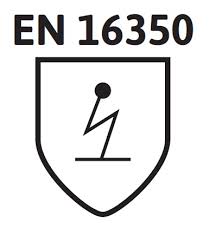PPE is crucial in the workplace for keeping yourself and your team safe. Identifying the right bits of gear to protect you from all the hazards you face can be difficult, so we have this guide here to help you out.
Choosing the Right Protective Gloves
Protective gloves make up an important part of the PPE framework and can help protect against numerous different hazards. The two main types of injuries that gloves can protect against are Contact Injuries and Traumatic Injuries. Contact injuries occur when hands and fingers come into contact with a hazard (extreme temperature, chemical or a blood borne pathogen) whereas traumatic injuries occur when hands and fingers are cut, pinched, punctured or otherwise injured by tools/machinery.
When selecting the correct protective gloves you must consider these 5 factors:
- The Substances Handled
- Other Hazards
- The Type and Duration of Contact
- The User – Both Size and Comfort
- The Task at Hand
Different gloves are designed differently in regards to design, material and thickness for the substances and hazards they are to protect from, with no glove material able to protect from all substances/hazards nor protect against a specific substance/hazard forever.
Water/Wet Work
Contact with water frequently or for a prolonged period of time, particularly when in combination with soaps and detergents can cause dermatitis.
The European Standard EN374-2 indicates that the gloves are waterproof and will protect hands against the hazards of Wet Work.
Heat and Cold
Insulated gloves offer the best protection for tasks that involve either hot or very cold materials or when exposed to cold environments. If the worker is subject to a radiant heat source, insulated gloves made from reflective materials may be necessary to provide satisfactory protection.
The standards to look for are EN407 for thermal hazards while EN511 is the relevant standard for cold protection
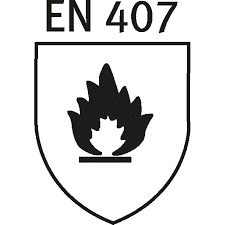
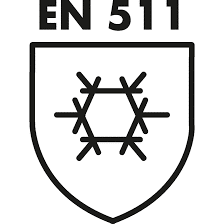
Fire Protection
Gloves made from fire retardant materials provide the best protection for workers who may come into contact with an open flame.
High levels of performance (3 or 4) in standard EN407 are required for gloves to safely come into contact with an open flame.
Electricity
Tasks that involve the potential exposure to electrical hazards may require gloves made from insulating rubber materials
Look for Standard EN 16350 for the level of protection against electrical hazards.
Substances in Products, Created by Work Processes and Natural Substances
Some products contain substances that can harm the skin or enter the body through skin contact. Product labels and Material Data Safety Sheets contain the information regarding whether this is the case. Substances can be generated during work activities (e.g. wood dust by sanding or solder fumes). Some natural substances such as foods and flowers can cause skin problems as well.
Chemicals
For protection against substances and chemicals, there are many types of suitable glove. Depending on the nature of the chemical and the type of potential exposure (Constant or Incidental), different materials will result in better protection. The same goes for the different types of chemical that the glove will come into contact with, with different materials offering better protection against certain chemicals. Consulting the relevant Material Safety Data Sheet (MSDS) will help in deciding which glove will offer the best protection.
3 Key terms to pay attention to when considering which glove is best are Breakthrough Time, Permeation Rate and Degradation Rate. Breakthrough Time refers to the time it takes for a chemical to permeate through the material of the glove and indicates the amount of time that the glove can be used for. The Permeation Rate is the amount that then permeates through, with a higher rate meaning that more of the chemical will move through the glove (the lower the rate the better). Finally Degradation Rate indicates the deterioration of the glove material on contact with specific chemicals as some can destroy the material of the glove. Gloves with a degradation of excellent or good rating are ideal.
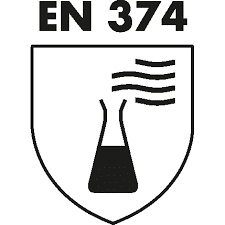
European Standard EN374 is the relevant standard for gloves that offer a level of protection against chemicals.
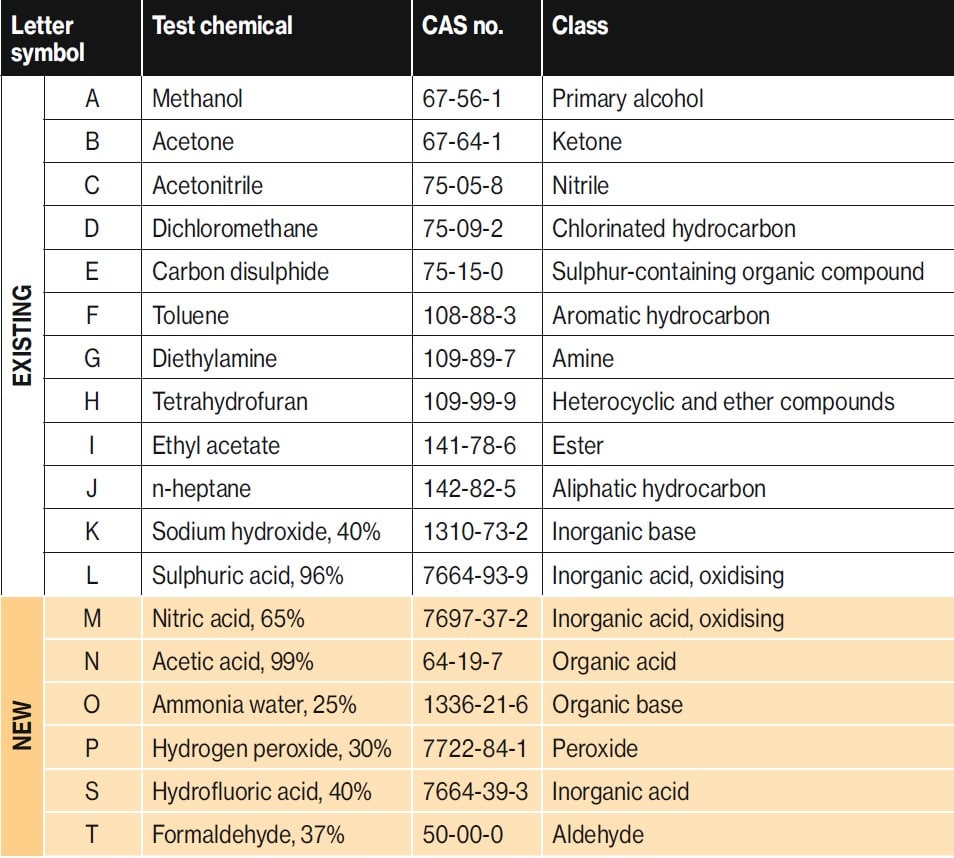
This table shows the chemicals that are tested on gloves under the EN374 Standard.
Delicate Materials
In some cases, the purpose of the glove is to protect the material from the worker. In these scenarios, gloves made from soft materials such as cotton may be optimal.
Mechanical Standards
The mechanical standards for gloves are shown on the glove through the below symbol. The higher the number, the higher the level of protection.
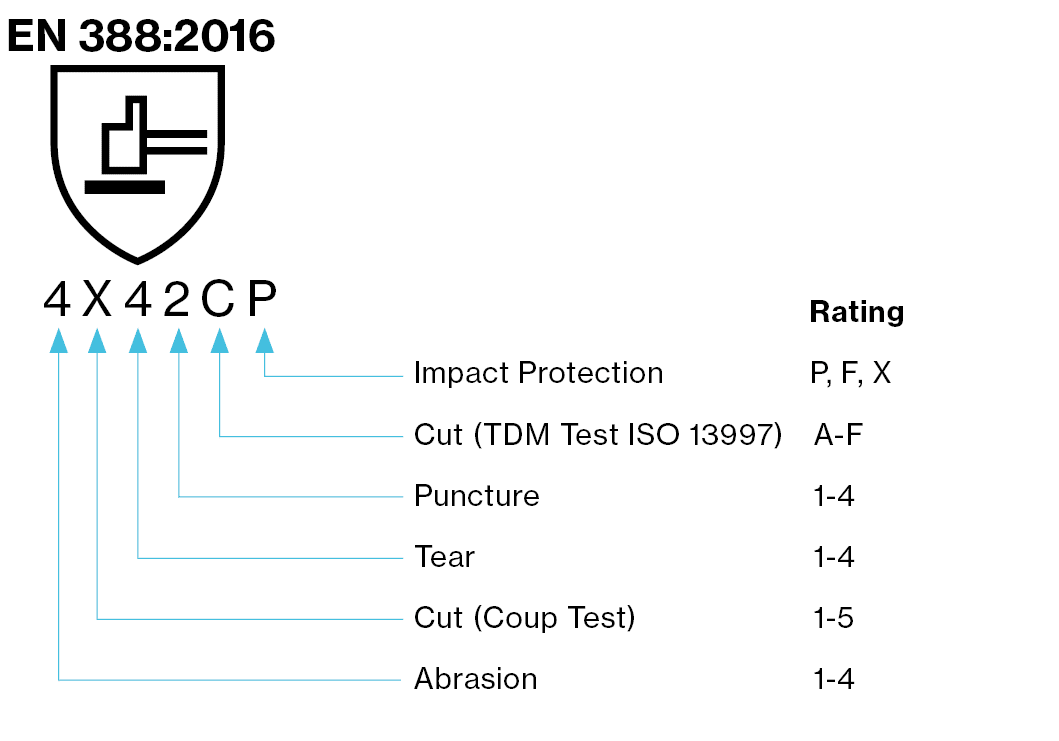
Abrasion Resistance
The Abrasion resistance number refers to the number of cycles that the glove material can handle of a course or rough surface before reaching failure.
Cut Protection
Workers who come into contact with sharp objects or surfaces that are jagged and rough may require cut-resistant gloves. There are multiple different materials that offer differing levels of protection. To work out which level of protection is necessary use the cut resistance rating, Cut-1 for general purpose through to Cut-5 for the safe handling of glass.
Tear Resistance
This refers to the force the glove can withstand before it becomes torn/ripped
Puncture Resistance
This is the amount of force the glove can withstand before the glove is pieced by a standard point.
Cut Protection (TDM Test ISO 13997)
This is the updated testing method relating to the cut protection for gloves that are designed to cause blades to become blunt in the action of cutting. It goes through a A-F scale with A offering the least protection (≥2N) to F (≥30N) offering the most.
Impact Protection
Impact protection is rated on a pass or fail condition, with the letter P indicating the gloves do provide protection while F indicates that they do not. The letter X is present if the gloves have not been tested under this metric.
And if you need any help deciding what the best glove for your business is, you can contact the helpful experts at Sedl Agencies.


